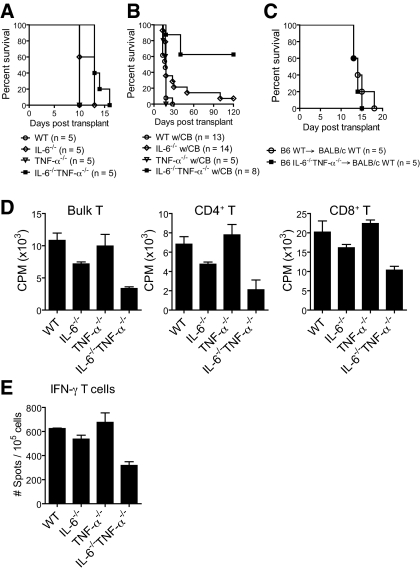Figure 1.
Absence of both recipient IL-6 and TNF-α synergizes with the administration of co-stimulatory blockade to induce permanent allograft acceptance. (A and B) C57BL/6 WT, IL-6−/−, TNF-α−/−, and IL-6−/−TNF-α−/− recipients received a BALB/c skin allograft and were untreated (A) or administered co-stimulatory blockade (CB; CTLA4-Ig and anti-CD154) (B). Without co-stimulatory blockade, all experimental groups rejected their allografts at a similar rate. When co-stimulatory blockade was administered, most IL-6−/−TNF-α−/− recipients accepted their allograft for >100 d (P < 0.0001, log rank versus WT; P = 0.004 versus IL-6−/−). Only a minority of IL-6−/− recipients exhibited extended allograft survival compared with the WT group, although this reached statistical significance (P = 0.01). TNF-α−/− rejected their allografts at a similar rate to WT. (C) Full-thickness C57BL/6 WT and IL-6−/−TNF-α−/− skin was transplanted to BALB/c recipients, which were administered CTLA4-Ig and anti-CD154. There was no difference in allograft survival times between the groups. (D and E) C57BL/6 WT, IL-6−/−, TNF-α−/−, and IL-6−/− TNF-α−/− recipients (n > 3 per group) received a BALB/c skin allograft and were treated with co-stimulatory blockade (CTLA4-Ig and anti-CD154). At day 21 after transplantation, bulk T cells, CD4+ and CD8+ T cells, were purified from spleens and stimulated ex vivo with irradiated donor spleen cells for <24 h. T cell proliferation (D) and IFN-γ responses were then measured (E). T cells purified from and IL-6−/−TNF-α−/− recipients manifest significantly reduced responses versus the other groups in all of the assays (P < 0.05).

